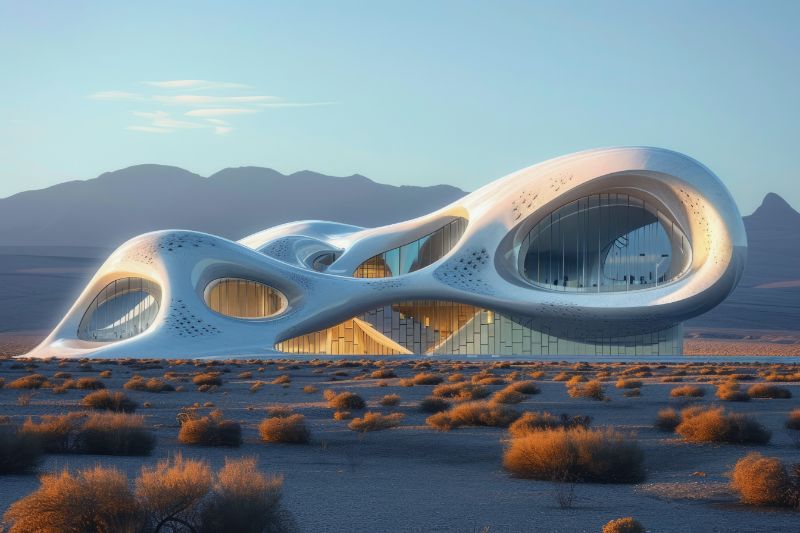You’ve likely admired some remarkable futuristic structures, but have you ever pondered the design philosophies behind them? Futuristic architecture isn’t just about creating visually stunning edifices; it’s a bridge between cutting-edge technology and our built environment. It’s where buildings don’t just house us, but interact, adapt, and even sustain themselves. From buildings that generate their own energy to prototypes for colonies on Mars, the scope is vast. There’s a lot to explore in this architectural realm, wouldn’t you agree?
Origins of Futuristic Architecture
Diving into the origins of futuristic architecture, you’ll find it sprouted from the Futurism movement in Italy during the early 20th century, a time when speed, technology, and the machine age were celebrated.
Italian Futurism, led by influential figures like Italian architect Antonio Sant’Elia, marked a radical departure from traditional architectural styles. Sant’Elia’s Manifesto of Futurism championed modernity, embracing the technological advancements of the era.
This design process brought about futuristic buildings that were a testament to progress and movement. The Art Deco movement also had a hand in shaping this new aesthetic, adding elegance to the dynamism of Futurist Architecture.
These movements proudly rejected the past, focusing instead on the promise of a fast-paced, technology-driven future.
Evolution of Futuristic Design
As you journey through the evolution of futuristic design, you’ll see how it took root in Italian Futurism, then morphed and adapted, reflecting cultural shifts from the 1930s speed and motion obsession to the space-age fascination of the 1940s, the tech-integrated experiments of the 1960s, and the industrial aesthetics of the 1970s postmodernism.
This progression birthed new architectural concepts, like Googie architecture, inspired by space travel and car culture. Futuristic design also embraced Le Corbusier’s visionary blend of structural elements, natural light, and ventilation, a trend still evident in New York’s skyscrapers today.
Each phase of this evolution transformed futuristic architecture, integrating technology and industrial aesthetics, while maintaining a focus on creating spaces that harmonize with the natural environment.
Iconic Futuristic Structures
Now, let’s turn our attention to some iconic futuristic structures that not only reflect the evolution of design but also push the boundaries of architecture.
The Atomium in Brussels, a masterpiece of mid-century futuristic architecture, features a series of stainless steel spheres that have become an unmissable part of the city’s built environment.
Meanwhile, the Crystal in East London, an example of contemporary design, uses a real-time energy monitoring system within its vast structure.
In Brazil, Santiago Calatrava’s Museum of Tomorrow showcases mobile solar panels in its exhibition spaces.
New York’s VIA 57 West catches the eye with its pyramidal form, while Taipei’s Tao Zhu Yin Yuan, with its twisting double helix design, integrates a natural ventilation system.
Each of these iconic structures redefines architectural aesthetics and functionality.
Impact of Technology on Architecture
Let’s explore how digital technology like Building Information Modeling (BIM) has been a game changer in the architectural design process. Influenced by visionaries like Le Corbusiers and Antonio SantElia, today’s architects can visualize and optimize designs before construction starts.
Robotic prototyping, a modern twist on traditional construction methods, allows for intricate structures. Reinforced concrete is being replaced by advanced building materials, making designs by SantElia a reality.
Interior design also benefits, with sustainable solutions like photovoltaic cells and rainwater harvesting seamlessly integrated. This isn’t just about aesthetics: it’s about creating efficient, sustainable spaces.
Technology’s impact on architecture is profound, transforming not only how we build, but what we build.
The Future of Futuristic Architecture
Building on the transformative role of technology in architecture, the future of this field promises even more groundbreaking innovations. Imagine Zaha Hadid’s Convention Center, blending with digital technologies to create a structure resembling flying saucers. This is a glimpse of the innovative designs in futuristic architecture.
Architects are increasingly exploring space dwellings in their speculative projects, blurring the lines between reality and science fiction. This trend shows a growing interest in interstellar architecture. Just imagine, your future home mightn’t be on Earth, but on Mars.
With the continuous evolution of technology, these wild imaginations and concepts are slowly turning into reality. So, brace yourself for a future where the boundaries of architecture aren’t just limited to our world, but reach out to the stars.
Conclusion
So, you see, futuristic architecture isn’t just about wild designs. It’s a celebration of speed, technology, and modernity.
It’s reshaping our world, from iconic structures like the Atomium to innovative tech like BIM.
And it’s not stopping there. With architects already dreaming up interstellar designs, the future of architecture is set to be out of this world.
It’s not just about buildings, it’s about pushing boundaries and envisioning a world beyond our own.
Check out more articles:
https://chronicle-future.co.uk/news/2024/05/16/futuristic-fashion/
https://chronicle-future.co.uk/news/2024/05/16/futuristic-names/

Leave a Reply